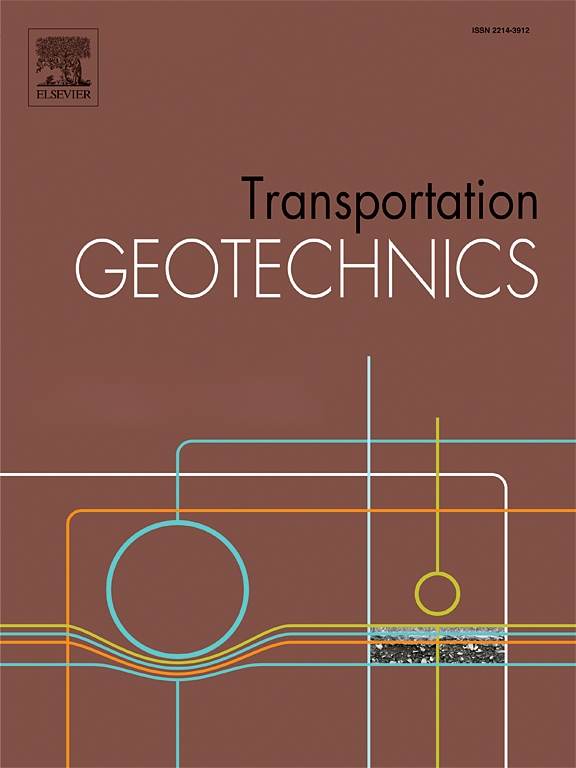Experimental studies and sustainability assessments of use of reclaimed asphalt pavement (RAP) in pavement layers
IF 5.5
2区 工程技术
Q1 ENGINEERING, CIVIL
引用次数: 0
Abstract
This study examines the feasibility and sustainability benefits of incorporating reclaimed asphalt pavement (RAP) into subgrade and subbase layers, aiming to reduce cement consumption in soil stabilization practices. The rising volume of RAP waste, driven by road maintenance activities, presents environmental and economic challenges. While previous research has demonstrated the effectiveness of RAP in base and subbase layers when blended with aggregate materials, studies focusing on RAP for soil stabilization in subgrade and subbase layers are limited. This study presents experimental results on various mix designs, including Unconfined Compressive Strength (UCS) tests to evaluate their strength with and without exposure to Wetting-Drying (W-D) cycles. The findings indicate that RAP-cement mixes with reduced cement content- 15 % RAP with 4 % cement (S-4C-15RAP) and 20 % RAP with 6 % cement (S-6C-20RAP)- meet the 7-day strength requirements for subgrade and subbase layers, similar to the conventional 8 % cement mix (S-8C). Durability tests demonstrated that these RAP-cement mixes retained more than 70 % of their strength after 14 W-D cycles, outperforming mixes with higher cement content. Microstructure analysis using Scanning Electron Microscopy (SEM) revealed strong bonds between RAP particles and cement hydration products, contributing to improved strength and durability. A multi-criteria sustainability assessment revealed that incorporating RAP with lower cement dosages significantly reduced both environmental and economic impacts. The sustainability index (ISUS) for S-4C-15RAP was 49 % lower than the traditional 8 % cement mix (S-8C), highlighting RAP’s potential as a sustainable alternative. These findings suggest that RAP can effectively reduce cement content in soil stabilization, offering a sustainable and cost-effective alternative to traditional cement-based methods.
再生沥青路面(RAP)在路面层内使用的试验研究及可持续性评价
本研究探讨了将再生沥青路面(RAP)纳入路基和亚基层的可行性和可持续性效益,旨在减少土壤稳定实践中的水泥消耗。在道路维修活动的推动下,RAP废物量不断增加,对环境和经济构成挑战。虽然之前的研究已经证明了RAP在基层和亚基层与骨料混合时的有效性,但专注于RAP在路基和亚基层土壤稳定方面的研究有限。本研究展示了各种混合料设计的实验结果,包括无侧限抗压强度(UCS)测试,以评估其在干湿循环和不干湿循环下的强度。研究结果表明,降低水泥含量的RAP-水泥混合物- 15% RAP和4%水泥(S-4C-15RAP)和20% RAP和6%水泥(S-6C-20RAP)-满足路基和亚基层的7天强度要求,类似于传统的8%水泥混合物(S-8C)。耐久性测试表明,经过14次W-D循环后,rap -水泥混合料的强度保持了70%以上,优于水泥含量较高的混合料。利用扫描电镜(SEM)进行的微观结构分析显示,RAP颗粒与水泥水化产物之间存在强粘结,有助于提高强度和耐久性。一项多标准可持续性评估显示,将RAP与较低水泥用量相结合,可显著减少对环境和经济的影响。S-4C-15RAP的可持续性指数(ISUS)比传统的8%水泥混合物(S-8C)低49%,突出了RAP作为可持续替代方案的潜力。这些研究结果表明,RAP可以有效地降低土壤稳定中的水泥含量,为传统的水泥基方法提供了一种可持续且经济的替代方案。
本文章由计算机程序翻译,如有差异,请以英文原文为准。
求助全文
约1分钟内获得全文
求助全文
来源期刊

Transportation Geotechnics
Social Sciences-Transportation
CiteScore
8.10
自引率
11.30%
发文量
194
审稿时长
51 days
期刊介绍:
Transportation Geotechnics is a journal dedicated to publishing high-quality, theoretical, and applied papers that cover all facets of geotechnics for transportation infrastructure such as roads, highways, railways, underground railways, airfields, and waterways. The journal places a special emphasis on case studies that present original work relevant to the sustainable construction of transportation infrastructure. The scope of topics it addresses includes the geotechnical properties of geomaterials for sustainable and rational design and construction, the behavior of compacted and stabilized geomaterials, the use of geosynthetics and reinforcement in constructed layers and interlayers, ground improvement and slope stability for transportation infrastructures, compaction technology and management, maintenance technology, the impact of climate, embankments for highways and high-speed trains, transition zones, dredging, underwater geotechnics for infrastructure purposes, and the modeling of multi-layered structures and supporting ground under dynamic and repeated loads.
 求助内容:
求助内容: 应助结果提醒方式:
应助结果提醒方式:


